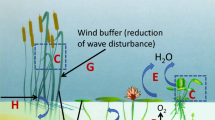Abstract
Dense beds of aquatic macrophytes often cause nuisance to boaters and swimmers, and may obstruct water flow. Management of aquatic vegetation is, therefore, often aimed at reducing the biomass of the plants. If the nuisance is caused by exotic invasive species, there usually is no controversy with nature conservation aims. In shallow lakes, however, the interests of recreational users may conflict with nature conservation because the promotion of indigenous submerged vegetation is considered an important tool for lake restoration. Aiming at intermediate vegetation biomass seems a good solution for this controversy at first sight. However, we argue that such a compromise is often not the best policy from a welfare economic point of view. We present preliminary results of a graphical model, showing that the overall benefit for all ecosystem users may be minimal at the intermediate vegetation biomass. Furthermore, even if there is an optimal benefit at an intermediate macrophyte biomass, we argue that it is may not always be feasible to force the vegetation biomass to the desired level. Due to ecological feedback mechanisms, the system can have two alternative stable states: one with high vegetation biomass and one with little or no vegetation. It is concluded that it will often be better to realise a management strategy aimed at keeping some lakes (or parts of lakes) free of aquatic plants, whereas allowing others to be densely vegetated.
Similar content being viewed by others
References
Best, E. P. H., 1987. The submerged macrophytes in Lake Maarsseveen I, the Netherlands: changes in species composition and biomass over a six-year period. Hydrobiol. Bull. 21: 55–60.
Boggess, W. G., G. Johns & C. Meline, 1997. Economic impacts of water quality programs in the Lake Okeechobee Watershed of Florida. J. Diary Sci. 80: 2682–2691.
Caffrey, J. M. & P. M. Wade, 1996. Preface: The European Weed Research Society and the management and ecology of freshwater plants. Hydrobiologia 340: IX-XIII.
Carson, R. G. & R. J. Mitchell, 1993. The value of clean water: the public's willingness to pay for boatable, fishable and swimmable quality water. Wat. Resour. Res. 29: 2445–2454.
Clayton, J. S., 1998. Aquatic plant management in New Zealand: achievements and directions. In Monteiro, A., T. Vasconcelos & L. Catarino (eds), Proceedings of the 10th EWRS International Symposium on Aquatic Weeds: Towards an Integrated Aquatic Plant Management. Lisbon 21–25 September 1999. European Weed Research Society: 335–340.
Clayton, J. S. & C. C. Tanner, 1988. Selective control of submerged aquatic plants to enhance recreational uses for water bodies. Verh. int. Ver. Theor. Angew. Limnol. 23: 1518–1521.
Coops, H. & R. W. Doef, 1996. Submerged vegetation development in two shallow, eutrophic lakes. Hydrobiologia 340: 115–120.
Crawford, S. A., 1979. Farm pond restoration using Chara vulgaris vegetation. Hydrobiologia. 62: 17–32.
De Winton, M. D. & J. S. Clayton, 1996. The impact of invasive submerged weed species on seed banks in lake sediments. Aquat. Bot. 53: 31–45.
Dixon, J. A., L. Fallon, R. A. Carpenter & J. A. Sherratt, 1994. Economic Analysis of Environmental Impacts. Earthscan Publications, London: 210 pp.
Hanley, N. & C. Spash, 1993. Cost-benefit analysis and the environment. Edward Elgar Publishing Limited, Aldershot: 278 pp.
Hargeby, A., G. Andersson, I. Blindow & S. Johansson, 1994. Trophic web structure in a shallow eutrophic lake during a dominance shift from phytoplankton to submerged macrophytes. Hydrobiologia 280: 83–90.
Hasler, A. D. & E. Jones, 1949. Demonstration of the antagonistic action of large aquatic plants on algae and rotifers. Ecology 30: 346–359.
Herath, G., 1997. Freshwater algal blooms and their control: Comparison of the European and Australian experience. J. envir. Mgmt 51: 217–227.
McNaughton, S. J., 1984. Grazing lawns animals in herds plant form and coevolution. Am. Nat. 124: 863–886.
Mumma, M. T., C. E. Cichra & J. T. Sowards, 1996. Effects of recreation on the submersed aquatic plant community of Rainbow River, Florida. J.Aquat.Plant Mgmt. 34: 53–56.
Murphy, K. J. & J. W. Eaton, 1983. Effects of pleasure-boat traffic on macrophyte growth in canals. J. appl. Ecol. 20: 713–729.
Nuttall, P. M. & J. L. Richardson, 1989. Incompatible recreationoriented benefits in a residential tidal canal estate and marina, Victoria (Australia). Wat.Sci.Technol. 21: 273–279.
Perman, R., Y. Ma & J. McGilvray, 1996. Natural Resource and Environmental Economics. Longman, London: 396 pp.
Perrow, M. R., M. L. Meijer, P. Dawidowicz & H. Coops, 1997a. Biomanipulation in the shallow lakes: State of the art. Hydrobiologia 342: 355–365.
Perrow, M. R., J. Schutten, J. R. Howes, T. Holzer, F. J. Madgwick & A. J. D. Jowitt, 1997b. Interactions between coot (Fulica atra) and submerged macrophytes: the role of birds in the restoration process. Hydrobiologia 342: 241–255.
Scheffer, M., 1990. Multiplicity of stable states in freshwater systems. Hydrobiologia 200/201: 475–486.
Scheffer, M., 1998. Ecology of Shallow Lakes. Chapman and Hall, London: 357 pp.
Timms, R. M. & B. Moss, 1984. Prevention of growth of potentially dense phytoplankton populations by zooplankton grazing in the presence of zooplanktivorous fish in a shallow wetland ecosystem. Limnol.Oceanogr. 29: 472–486.
Van den Berg, M. S., H. Coops, M. L. Meijer, M. Scheffer & J. Simons, 1998. Clear water associated with a dense Chara vegetation in the shallow and turbid Lake Veluwemeer, the Netherlands. In Jeppesen, E., Ma. Sondergaard, Mo. Sondergaard & K. Kristoffersen. (eds), Structuring Role of Submerged Macrophytes in Lakes. Springer-Verlag, New York: 339–352.
Van Donk, E., E. De Deckere, J. G. P. Klein Breteler & J. T. Meulemans, 1994. Herbivory by waterfowl and fish on macrophytes in a biomanipulated lake: Effects on long-term recovery. Verh. int. Ver. Theor. Angew. Limnol. 21: 2139–2143.
Varian, H. R., 1996. Intermediate Microeconomics, a Modern Approach. Norton & Company, New York: 650 pp.
Author information
Authors and Affiliations
Corresponding author
Rights and permissions
About this article
Cite this article
Van Nes, E.H., van den Berg, M.S., Clayton, J.S. et al. A simple model for evaluating the costs and benefits of aquatic macrophytes . Hydrobiologia 415, 335–339 (1999). https://doi.org/10.1023/A:1003821314662
Issue Date:
DOI: https://doi.org/10.1023/A:1003821314662




